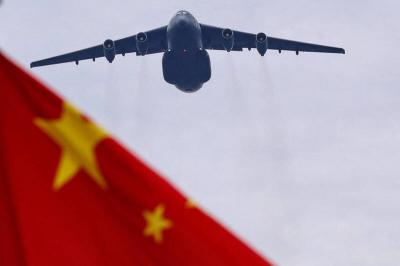An unmanned aerial vehicle (UAV) developed by National Cheng Kung University (NCKU) successfully completed its maiden flight, marking a new milestone in Taiwan’s progress in the field, academic sources said on Wednesday.
The unmanned aircraft, dubbed Spoonbill UAV, successfully flew 92km from Taiwan proper to Penghu on Tuesday in what was the first flight of its kind across the Taiwan Strait, NCKU said in a press statement.
NCKU president Michael Lai (賴明詔), also an Academia Sinica academic, was quoted in the statement as saying that the unprecedented flight was not only an achievement for the university, but was also “Taiwan’s pride.”
“It is also an important achievement in Asia,” Lai said, adding that NCKU’s UAV technology was the “cream of Taiwan” and the “best of Asia.”
The NCKU research team arrived with the 30kg aircraft early on Tuesday morning at an airstrip it had specially constructed on a salt flat in Cigu (七股), Tainan County.
The team then installed the antenna and activated the mainframe computer in preparation for the test.
The drone took off at 9:20am under manual remote control, flying at 100kph at an altitude of 300m toward Penghu’s Dongji Island (東吉嶼).
Ten minutes after takeoff it was beyond the team’s field of vision and switched to automatic control.
For about 30 minutes or so the team lost computer contact with the aircraft and there was some anxiety.
However, at about 10am, the mainframe computer began receiving information from the aircraft again and the research team piloted it by remote control to land at 10:17am on Dongji, completing the 52-minute flight.
The NCKU’s Remotely Piloted Vehicle & Micro Satellite Research Laboratory (RMRL) built the Spoonbill UAV in April this year after 20 years of research and development.
The aircraft is 2.2m long, 3.7m wide and 0.9m high.
In 2005, the team also completed a successful 16km test flight of the smaller Swan UAV from Donggang (東港), Pingtung County, to Liuchia (小琉球) island.
Department of Aeronautics and Astronautics professor Hsiao Fei-bin (蕭飛賓) said a complete UAV should operate with two major systems — on board systems and a ground station that allows researchers to control the vehicle’s movement and monitor the images transmitted by an onboard camera.
Hsiao said a UAV developed in Australia more than a decade ago was able to fly more than 1,000km, but the vehicle was not equipped with an automatic flight system, onboard camera, video transmitter or GPS aviation system.
“That vehicle lagged far behind the Spoonbill in terms of technology,” he said.
The Spoonbill’s onboard systems include a wireless module for a data link between the aircraft and the ground control station, an onboard surveillance camera that takes aerial video and images as well as a video transmitter that transmits onboard video to the control station in real time.
Hsiao said that 80 percent of the Spoonbill’s parts and components were made in Taiwan.

Beijing could eventually see a full amphibious invasion of Taiwan as the only "prudent" way to bring about unification, the US Department of Defense said in a newly released annual report to Congress. The Pentagon's "Annual Report to Congress: Military and Security Developments Involving the People's Republic of China 2025," was in many ways similar to last year’s report but reorganized the analysis of the options China has to take over Taiwan. Generally, according to the report, Chinese leaders view the People's Liberation Army's (PLA) capabilities for a Taiwan campaign as improving, but they remain uncertain about its readiness to successfully seize

Taiwan is getting a day off on Christmas for the first time in 25 years. The change comes after opposition parties passed a law earlier this year to add or restore five public holidays, including Constitution Day, which falls on today, Dec. 25. The day marks the 1947 adoption of the constitution of the Republic of China, as the government in Taipei is formally known. Back then the Chinese Nationalist Party (KMT) governed China from Nanjing. When the KMT, now an opposition party in Taiwan, passed the legislation on holidays, it said that they would help “commemorate the history of national development.” That

Taiwan has overtaken South Korea this year in per capita income for the first time in 23 years, IMF data showed. Per capita income is a nation’s GDP divided by the total population, used to compare average wealth levels across countries. Taiwan also beat Japan this year on per capita income, after surpassing it for the first time last year, US magazine Newsweek reported yesterday. Across Asia, Taiwan ranked fourth for per capita income at US$37,827 this year due to sustained economic growth, the report said. In the top three spots were Singapore, Macau and Hong Kong, it said. South

Snow fell on Yushan (Jade Mountain, 玉山) yesterday morning as a continental cold air mass sent temperatures below freezing on Taiwan’s tallest peak, the Central Weather Administration (CWA) said. Snowflakes were seen on Yushan’s north peak from 6:28am to 6:38am, but they did not fully cover the ground and no accumulation was recorded, the CWA said. As of 7:42am, the lowest temperature recorded across Taiwan was minus-5.5°C at Yushan’s Fengkou observatory and minus-4.7°C at the Yushan observatory, CWA data showed. On Hehuanshan (合歡山) in Nantou County, a low of 1.3°C was recorded at 6:39pm, when ice pellets fell at Songsyue Lodge (松雪樓), a